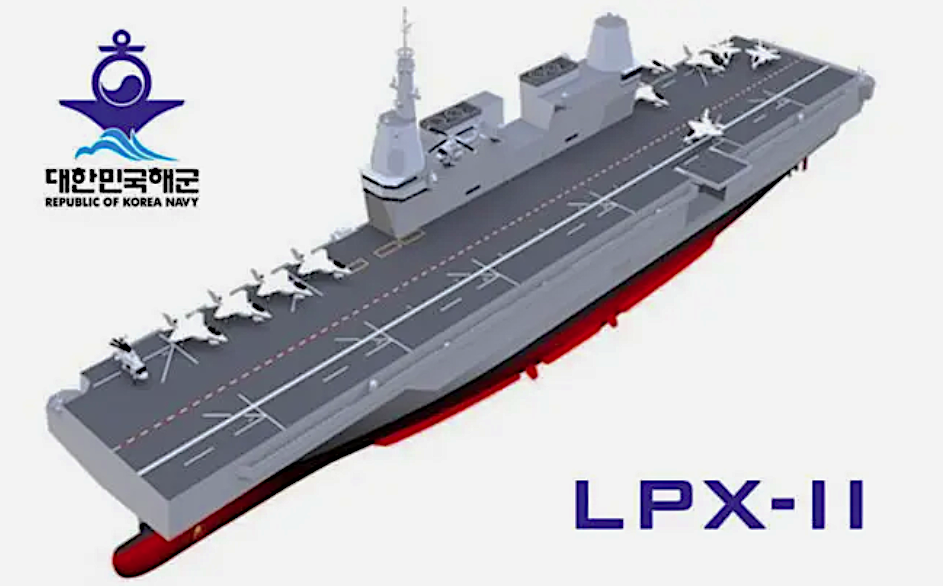
South Korea’s 2021-2025 defense blueprint, which was revealed yesterday, provides fresh details on the plans to develop an aircraft carrier capability for the Republic of Korea (RoK) Navy. The LPX-II project will be a dedicated light aircraft carrier for F-35B; it will not be an amphibious assault ship.
The LPX-II program originally meant to be an amphibious assault ship similar to the U.S. Navy’s Wasp-class of big deck amphibious warships, has now been officially revealed as a dedicated light aircraft carrier project. This means LPX-II will not have amphibious support capability — no well deck — and the vessel will be dedicated to air operations, with F-35B and rotary wings. The configuration is more like the first two amphibious warships in the U.S. America-class.
LPX-II is expected to displace around 30,000 tons — likely over 40,000 tons at full load. Details on the program have been very limited until now due to the geopolitical climate and because it is still very early in the program. Originally scheduled to be launched in 2033, LPX-II’s project schedule has been fast-tracked for launch in the late 2020s.
The acquisition of F-35B Lightning II has also been fast-tracked. The F-35B will be operated by the Air Force and will be acquired separately from 20 additional F-35As. This means ROKAF will operate a total of 80 F-35s (60 F-35As and 20 F-35Bs).
South Korea is not the only Asian country with ambition to develop a limited carrier aviation capability for its navy: Both Japan and Singapore are actively working towards the procurement of F-35B.
The South Korean Ministry of National Defense 2021-2025 Midterm Defense Acquisition Plan published yesterday highlighted other naval programs besides the LPX-II:
Naval Warfare Capability Improvement
- Light Aircraft Carrier acquisition will formally begin in 2021
- Light Aircraft Carrier (30,000 tons empty) will embark STOVL fighter jets and will serve as flagship of the mobile fleet
- In order to protect sea lanes and overseas Korean interests, the mobile fleet will be strengthened through the acquisition of additional AEGIS destroyers (KDX-III Batch-II) and KDDX next-generation destroyers.
- In addition to fielding 3,000 ton attack submarines (KSS-III Batch-I), new 3,600 ton and 4,000 ton submarines with increased armament and endurance will be constructed (KSS-III Batch-II/III).
- 24hr maritime surveillance coverage will be increased by 1.5
- Marine Corps will continue to acquire new utility helicopters, attack helicopters, fast landing ships, and new KAAV-II amphibious assault vehicles to strengthen their amphibious capability
11 New Acquisition Programs (joint or naval related programs in italics)
- Micro Synthetic Aperture Radar Satellite (100kg; late 2020s)
- Korean-GPS (mid-2030s)
- L-SAM production
- Future Infantry Equipment Production
- Additional fast combat support ship (AOE-II; additional construction of Soyang-class AOE)
- Special Operations Helicopter (MH-47)
- Stealth UAV (Kaori-X)
- Multi-purpose Unmanned Ground Vehicle
- Unmanned Surface Vehicle
- Unmanned Sub-surface Vehicle
South Korean shipyard Hyundai Heavy Industries (HHI) was awarded a contract for the LPX-II conceptual design in October last year. The LPX-II project aims to build a new versatile large-deck landing ship for short take-off and vertical landing fighter jets.
HHI is expected to finish the conceptual design by the second half of 2020, and commissioning with the Republic of Korea Navy planned for the early 2030s. The vessel, displacing around 30,000 tons, would be based on the existing Dokdo-class amphibious assault ship (LPX-I project) but without a well deck, according to the latest information. It would be able to accommodate around 20 F-35B STOVL fighters.
The LPX-II vessel will also deploy future Marine Attack Helicopters of the ROK Marine Corps, for which there is an upcoming competition between local company KAI (with the Surion MAH), Bell Helicopters with the AH-1Z and Boeing with the AH-64 Apache.
A version of this post originally appeared on Naval News. It’s been republished here with permission.





